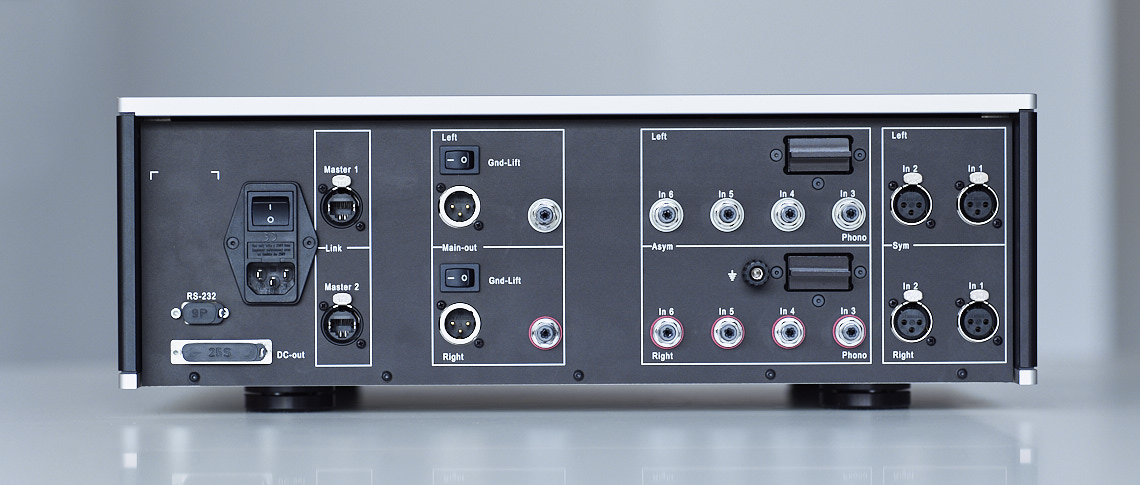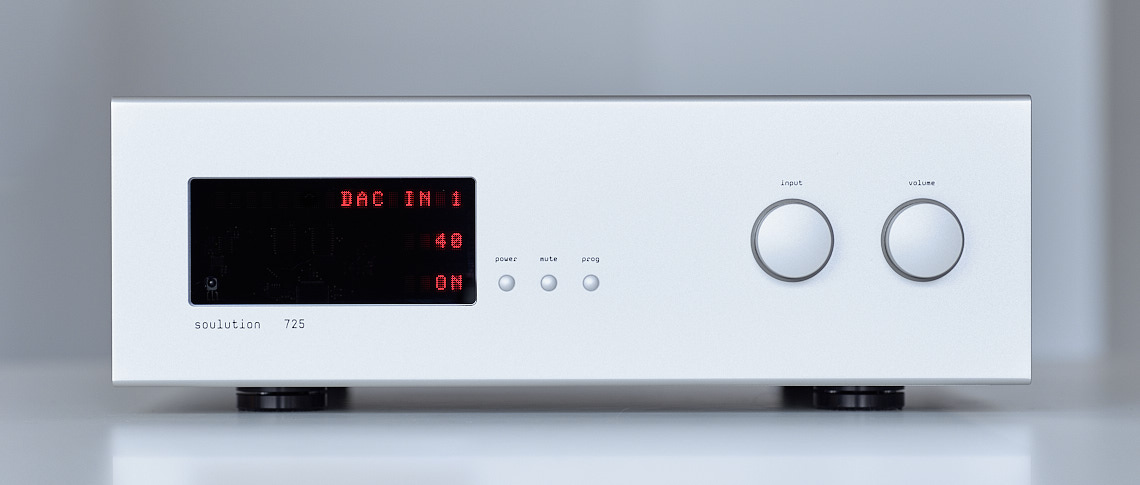Due to the new power supply technology the 725 preamplifier has an even more breathtaking three-dimensional sound quality than its predecessor the 720 already did. Unsurpassed wealth of detail. Incredible punch at low frequencies. Distortions and noise could be reduced even further. The preamplifier is the command centre of your high fidelity chain. In tests its sound quality has proved to be second to none.
New power supply technology
The 725’s totally redesigned power supply unit works even more precise and regulates more precise and faster than the power supply of the 720. With more than 500,000 µFarad of storage capacitance it provides almost unlimited impulse current for the analog circuits.
Highlights
Philosophy
A perfect preamplifier shows consistent level and phase performance regardless of load. At soulution we stick to this ideal without resorting to often-used compromises like high amplification with high negative feedback. The result: virtually no distortion, hum or noise, maximum channel separation and impressive bandwidth (up to 1 MHz/– 3 dB).
Design
As few components in the signal path as possible and a dual-mono layout with discrete left and right channels maximise audio purity and virtually eliminate crosstalk. Input selection (including the ground connection) is by high-grade relay. And input buffering ensures the 725 presents a benign load to source components.
Input levelling permits different source device levels to be accommodated. All inputs are monitored continually for residual DC with audiophile-grade blocking capacitors automatically switching in and out when required. In this way maximum operational safety is guaranteed. As a further safeguard the front panel display indicates when DC is present.
Volume control
The volume control uses high-precision, low-noise metal foil resistors, and controls both volume and balance. To block switching peaks during volume changes which may be hazardous to power amplifiers a second volume control with PGA (Programmable Gain Amplifier) is used. Active only when the volume is changed, it is similar to a potentiometer and enables the volume to be adjusted in smooth steps without clicks. As soon as the new desired level has been selected, the unit returns control to the precision resistors.
Output stage
Able to drive even long interconnects, the 725’s multi-stage signal amplification is similar to that of the 711 power amplifier. In most cases levels can be maintained with no further amplification of the audio signal.
The optimised circuitry is based on special power transistors which are further linearized by an analogue computing network. In this way a very fast, very precise and ultra wideband (2 MHz/– 3 dB) performance can be achieved.
Phono MC preamp optional)
Designing and building the ideal phono stage is an exacting challenge. It must provide up to 80dB gain – equivalent to raising the signal level by 10,000 – yet must exhibit level and phase true behaviour while adhering strictly to RIAA-IEC equalisation standards. In the 725 this goal is realised with an ultra wideband (1 MHz/– 3 dB) multi-stage amplifier built around the very highest quality components.
Power supply
Key to a good sounding amplifier is a stable, noise-free power supply – especially for the audio stages. The 725 is equipped with two dedicated power supplies: one for the audio stages and one for the digital circuits. For powering the audio stages an innovative, amplifier-like circuit design is used, providing an extremely stable supply voltage. The 725’s totally redesigned analog power supply unit works even more precise and regulates more precise and faster than the power supply of the 720.
With more than 500,000 µFarad of storage capacitance it provides almost unlimited impulse current for the analog circuits. Bus bars supply this power throughout the unit without loss. A unique concept in the audio world, this allows the same high quality supply to be delivered to all parts of the 725.
Operation
Operation of the 725 is through three buttons and a rotary control on the front panel. All operating modes are indicated on the clear display. Additionally there are many other functions which can be used to optimise and match an entire audio system around different components.
Specifications
| Mains | 220 – 240 V (50 – 60 Hz) 100 – 120 V (50 – 60 Hz) |
| Power consumption | < 0.5 W standby 60 W device in operation |
| Inputs | 2 × balanced (XLR) 3 × unbalanced (RCA) 1 × Phono-MC (optional) |
| Input impedance | 2 kΩ balanced (XLR) 47 kΩ unbalanced(RCA) 10 – 1000 Ω (adjustable) |
| Outputs | 1 × balanced (XLR) 1 × unbalanced (RCA) |
| Frequency response (– 3 dB) | 0 – 1 MHz |
| THD + N | < 0.00009% (20 Hz – 20 kHz) |
| Signal-to-noise ratio | > 140 dB |
| Channel separation | > 110 dB |
| Gain | + 9.5 dB balanced (XLR) + 3.5 dB unbalanced (RCA) + 54/60 dB Phono-MC unbalanced (optional) plus gain adaption + 3/+ 6/+ 9 dB |
| Volume control range | 0 to – 79 dB in 1 dB steps |
| Output impedance | 2 Ω balanced (XLR) 2 Ω unbalanced (RCA) |
| Output voltage | 16 VRMS balanced (XLR) 8 VRMS unbalanced (RCA) |
| Output current max | 1 A (limited by protection circuit) |
| Dimensions | 480 × 167 × 450 mm |
| Weight | approx. 30 kg |
| LINK (remote turn-on) | 12 V control signal |

